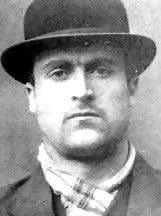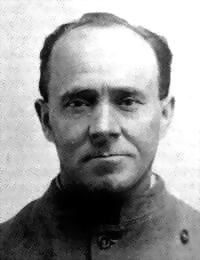Frederick Guy Brownewith William Kennedy
| AKA | |
| DOB | 1881 |
| Occupation | |
| Kill Total | 1 |
| Kill Place | Howe Green, Essex |
| Kill Date | 27 September 1927 |
| M.O. | Shooting |
| Victim | P.C. George William Gutteridge, 36 |
Tuesday 27th September 1927 Police Constable George William Gutteridge stopped a car containing two men which looked suspicious. Whilst he was taking their particulars, he was shot in the head from 10 inches away by the driver. The driver (according to the other man) then got out of the car and said to the stricken officer lying on the ground, “What are you looking at me like that for?” whereupon he again shot him through both eyes.A post office worker, was driving in Essex near Howe Green. He saw a body by a bank at the side of the road and found PC George Gutteridge wearing his full uniform and cape, with his helmet and notebook beside him, his pencil still in his hand. He had been murdered by being shot four times in the face.
About 10 miles away a Morris Cowley car belonging to a doctor had been stolen from his garage in London Road Billericay. Some of his medical instruments and some drugs were in the car. But by the time the theft was reported, the car itself had already been spotted 42 miles away in a narrow passage behind 21 Faxley Road, Brixton. There were blood splashes on one of the running boards.
The police recovered the car and found a cartridge case marked RLIV. This marking indicated that it was an old Mark IV type made at the Royal Laboratory in Woolwich Arsenal for troops in the First World War. The case seemed to have been scarred by a fault in the breech block of the gun which had fired it. The foremost gun expert of the day was Mr Robert Churchill who found that the bullet would have been fired by a Webley revolver.
It looked as if the murder of PC George Gutteridge was linked with the theft of the car. And the car's mileometer showed that it had been driven the same distance - 42 miles - as the distance from Dr Lovell's garage direct to Brixton - and the scene of the murder was on the direct route if the car had been driven along by-ways to avoid detection.
The murder hunt went on for over 4 months. The police suspected two car thieves Frederick Browne and Pat Kennedy but did not have any evidence. Two Webley revolvers were found in the River Thames, but Mr Churchill proved that they could not have been the murder weapon because they did not make the same mark on the cartridge cases.
Eventually the police had evidence against Browne for the theft of another car, a Vauxhall, and raided his premises. They found cartridges and a loaded Smith & Wesson in his room off Lavender Hill. He had been using a car he had part exchanged for the stolen Vauxhall the police were interested in. When the police searched that car they found yet another loaded revolver in a secret recess in the car. And it was a Webley.
It was that Webley which Mr Churchill examined and found to be the very same one which had caused the peculiar mark on the cartridge case. Later Browne's accomplice Patrick Kennedy was arrested, but only after he had pressed a loaded firearm into the ribs of Sergeant Mattinson of Liverpool Police and pulled the trigger. But the gun clicked as a bullet jammed in the barrel, Sergeant Mattinson survived and both Kennedy and Browne were now in custody.
23rd April 1928, At the Old Bailey trial before judge Horace Avory both men had to be kept apart in the dock by a group of warders. Counsel for both men applied for separate trials due to the “cut-throat defence” on Kennedy’s part (Browne had never accused Kennedy of committing the murder alone). This was refused by Avory, despite Kennedy’s statement being virtually the only evidence again Browne.
Browne went into the witness box and conducted his own defence, accounting for his movements on the murder night, whilst Kennedy did not, preferring to make a statement from the dock.
The two men were found guilty after a jury retirement of 5 hours and were sentenced to death. Kennedy was hanged at Wandsworth and Brown at Pentonville.
During his stay in the condemned cell Browne, continually protesting his innocence, he first went on hunger strike for 3 days, then tried to slit his throat and wrists.
Kennedy tried to feign insanity but a psychiatrist pronounced that he was exhibiting all the wrong symptoms!
The Sunday Dispatch newspaper carried the headline "Hanged by a microscope" reflecting the fact that microscopic examination of the cartridge cases had provided the crucial evidence to convict them of an awful murder.
31st May 1928, Both Browne and Kennedy were hanged. Browne at Pentonville, and Kennedy at Wandsworth.






